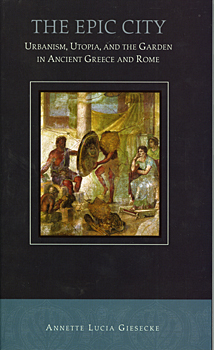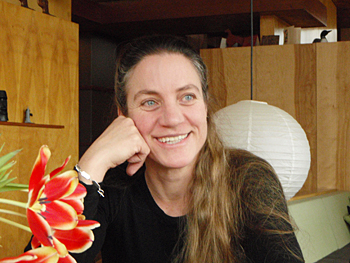
Drawing from a wide range of visual and literary sources, Giesecke traced the evolution of Greek and Roman attitudes toward the natural environment and examined the role ancient literature (especially the epic poems by Homer, Virgil and Lucretius) played in shaping the cultural attitudes and practices of the two cultures.
“This book is really the result of 25 years of thinking about the ancient world,” Giesecke said. “I mainly was looking back at past experiences when I wrote it, because I'd come to a point where I was able to connect all the things in my life that I love so much--Virgil's Aeneid, and Homer's Iliad and Odyssey, as well as Greek vase painting and Roman villas. Although I didn't set out to do that, the ideas came together, and because I was fortunate enough to go on leave around that time, I was able to write the first draft of the book in nine months.”
Giesecke emphasized that her travels to Greece and Italy--to the Acropolis and to Roman houses in Pompeii, in particular--shaped her ideas and fired her interest in writing the book. So did years of reading Classical literature, she said, and years of immersion in material culture, both ancient and modern.
“As a Classicist, one is not only a student of literature, but also of material culture,” said Giesecke, “and because I'm a trained art historian, as well as a philologist, I'm really what you'd call a 'classic Classicist.'
“I've always tried to achieve as holistic a view as possible of the Greek and Roman world. These days Classicists tend to focus on a single author, but I've been fortunate, through my training and experience, to be able to look at things from a broad vantage point and perhaps a different perspective.”
Because of that angle, Giesecke, who spent the year between her graduate studies at Harvard University and her dissertation interning at the J. Paul Getty Museum in Malibu, Calif., said she was able to explore new ideas and connections in The Epic City.
“To my knowledge, there is no one who has looked at Greek and Roman attitudes toward nature in this context and in this comprehensive a way,” she said. “That is, people have studied Greek gardens or Roman gardens, or both; but nobody, I think, has looked at the entire record that we have--literary, artistic and architectural--and that's what makes this [study] different: I've tried to look at everything.”
To do that, Giesecke said, was no small task, and was fueled as much by curiosity as by evidence. Yet, while she “didn't really set out thinking or knowing that the Homeric epics or works by the visionary poet Lucretius would answer [her] questions about the integration of nature into ancient Greek and Roman cultures,” she said she believed that the questions were strong enough to carry the project along.
“As I thought about Roman villas and gardens and the astonishing way that the Roman villa embraces and gives priority to the garden, I wondered why that was the case and why it was the case that the Greek house was so very different in the way it was designed like a fortress and assumed a defensive posture against nature,” she said.
This naturally led Giesecke to consider all the ancient classics she'd read, all the ancient Greek and Roman art she'd studied, and all the things she knew about Greek and Roman politics and cultures.

Giesecke widened this theme to Greek and Roman towns, which followed the same pattern; the Romans integrated nature enthusiastically with their civic planning while the Greeks did the opposite, banishing it to the hinterlands and taking precautions to keep it tamed and beyond the city walls. After drawing these parallels, she said, it was only a small step to follow the pattern in Greek and Roman literature.
“All the things that you can observe on the level of material culture, from looking at Roman and Greek houses and the topography of the Roman and Greek town, you can see in the literature,” Giesecke said. “The great epics--Homer's Iliad and Odyssey for Greece, and Virgil's Aeneid for Rome--have a Utopian content. They explore an optimum way for human beings to live in and with nature and an optimum way to order human society.
“Things that concerned the ancient Greeks and Romans continue to concern us now; we're still trying to find our place in nature. There are still places in the world where you can see a defensive posturing against nature,” Giesecke said. “On the other hand, what I find interesting these days is the strong contemporary shift to really cherish and embrace nature--to value the presence of open space, to look for alternative fuels, to take a stand on global warming, and to realize, ultimately, that we're part of a larger whole. Environmental and ecological concerns are nothing new. They occupied the Greeks and Romans, as well, and we have a lot to learn from them. I think, ultimately, that classical Greece suffered because it was overly defensive against nature.”
Giesecke's interest in architecture led her to explore this theme from yet another angle. “I've looked quite a lot at Modern architecture--at buildings by Frank Lloyd Wright, Le Corbusier, Neutra and others--and the way this architecture relates to the environment really interests me,” she said. “There are so many things that Modern and Roman domestic architecture have in common in terms of design and siting, where there's a real dialogue with nature. In this respect the Roman house is very like the Modern house.”
Giesecke, whose first book, Atoms, Ataraxy and Illusion (published in 2000 by Georg Olms Verlag, a German press) focused on Lucretius and his influence, said that her intent with The Epic City was to appeal to a broad readership.
“I hope to reach a wide audience of people with this book, and not just Classicists,” she said. “If you enjoy architecture and gardens and philosophy and literature, you should be able to find something of interest here.”
The Epic City, a 220-page illustrated paperback, is available at the UD Bookstore, as well as online through Amazon.com, for $18.95.
Article by Becca Hutchinson
Photo courtesy of Annette Giesecke
Book cover graphic courtesy of Harvard University Press

